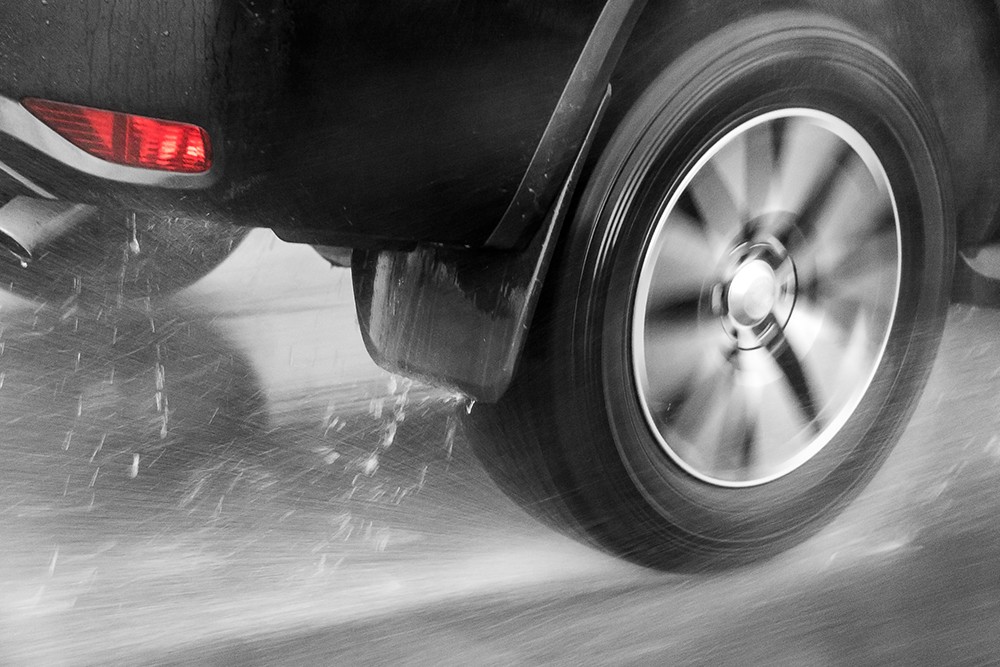All-Season Tires: Choosing Your Next Set Of Treads

by Jay Alling
You’ve felt the change of seasons and peaked at your tires. There’s some heavy wear on the edges and tread depth looks a bit thin.
How do you choose the right tire for your autumn excursions, something that can carry you and your family safely through a wet winter?
“The end of the summer is a good time to prepare for winter,” said Brad Robison, senior product manager for Bridgestone Americas. “Make sure you have the appropriate tires for the upcoming season.
“The rubber compounds in all-season tires make them a good choice for Mediterranean climates.”
The specific formulation of rubber compounds is a trade secret for tire manufacturers. It include natural rubber, synthetic rubber, steel, nylon, silica as well as petroleum products and other ingredients to improve tire resistance and wear
For autumn driving, Robison emphasized tread depth as a gauge of a tire’s ability to perform on wet roads.
“All-season tires are intended for drivers looking for long tread life and good traction in most weather conditions such as rain, cool weather and summer roads,” Robison said. “They’re very popular based on the convenience of being suitable for year-round driving, including mild winter conditions.”
Grooves and slits in all-season tread push water beyond the sidewall. Tires with worn out treads tend to hydroplane, or glide, on a thin layer of water rather than grip the road surface.
According to the U.S. Department of Transportation, tires should be replaced when tread depth reaches 2/32 of an inch. The measurement corresponds roughly to the distance between the top of head and edge on a one cent piece, a visual check known as the “penny test.”
“Once your tires do not meet the 2/32” standard, the features in the pattern cannot provide the same level of performance and safety,” Robison said. “It's ability to channel water and slush away from the tire’s footprint is diminished.”
Follow some simple guidelines when choosing your next all-season tire:
- Check tire tread depth to know if it's time to replace tires. All passenger tires have a “Tread Wear Indicator Bars,” small horizontal in tread channels. If tire tread has worn to the level of the wear indicator bar, your vehicle needs new tires.
- The “penny test” is another common method for checking tire wear. Place a penny upside down in the tread groove. If tread is at the level of Lincoln’s head, then tires need to be replaced.
- Long life and mild climates. All-season tires are designed to provide good tread wear with excellent grip on rainy roads. They have become the most popular choice for all-purpose use in family vehicles.
- Sipes, or small slits in the tread, give all-season tires the ability to flex and channel water. The number and arrangement of sipes differ by tire brand and driving application.
- “Tread depth features and advanced three dimensional sipes in the pattern can provide long lasting performance as the tire wears without compromising on the handling performance and wear life.”
- Extreme conditions. If you live in an area where winter lasts six or more months of the year, Consider winter tires for excellent grip in freezing temperatures.
- “Traditional all-season tires are designed to be suitable for mild winter conditions, but most likely will not deliver the snow performance needed in more regular winter conditions where you will be coming across deeper snow and/or ice-covered roads.”
- Driving habits and location. Drivers who use their vehicle infrequently on city streets may want all-season treads. Drivers who travel country roads may fare better with all-weather tires with the three-peak mountain system, a designation for tires designed for extra grip and snowy conditions.
- “All-weather tires are typically defined as a tire having the 3 Peak Mountain Snowflake mark certifying the winter performance while being designed for year-round use,” Robison said.
- Consider the six important trade-offs in tire selection: grip, tread life, fuel economy, comfort, safety and price.
- All-season tires come in a wide variety of performance levels in winter conditions, wet roads, comfort level, and mileage warranty. Ask your service advisor which one is best for where you live and where you travel.
“Tire technology has advanced in polymer science and innovative pattern features,” Robison said. “It enables all-season products to provide strong all-season capability while also providing a quiet comfortable ride and confident grip on rainy roads while delivering on as much as an 80,000 mile warranty.”
Jay Alling is editor of Sensible Driver. Write to jay@sensibledriver.com.